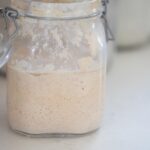Day 1: Combine one cup of whole wheat flour with one cup of filtered water in your glass bowl. Stir well, scraping down the sides of the bowl. Cover your bowl with a clean tea towel and let it sit at room temperature for 24 hours.
Day 2: Pour out and discard half of the flour and water mixture, then repeat the steps of day one. One cup of flour, one cup of water, stir thoroughly, cover, and set aside.
Day 3-5: For days 3, 4, and 5, repeat the instructions from day 2. Discard, feed, stir, cover, and wait 24 hours.
Day 6-7: Continue the steps from days 2-5, but begin feeding every 12 hours now, rather than every 24 hours.
Day 7: After one week, your new starter should be showing signs of activity. With the feeding schedule and elapsed time, enough wild yeast and good bacteria should be present to attempt your first rise. Look for bubble foam on top, bubbles throughout the starter, or doubling in size.
After day 7: Start baking with your sourdough starter. Store in the fridge if not using daily. Feed once a week in the fridge or at least every 12-24 hours at room temperature equal portions starter, water, and whole wheat flour.
